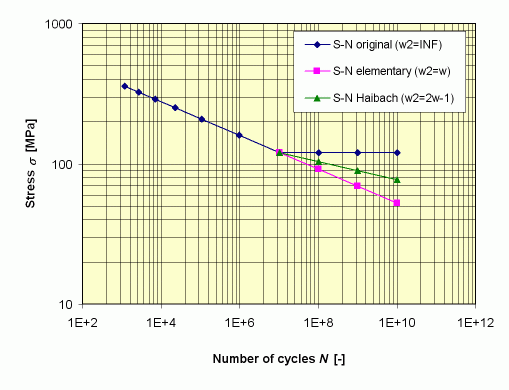S-N curve
In: Theory basis
There are many different forms of S-N (Stress σ - Number of cycles N) curves. PragTic uses the simplest form only:
![]() ,
,
where w is the exponent of the S-N curve (approx. in the range from 3 to 30) and C is a constant of the S-N curve. Since the real value of C is quite a big number (approx. > 1e20), the input of the curve into PragTic goes another way. It relates the curve to one specific point - the fatigue limit f at number of cycles Nf:
![]()
The exponent w relates to the slope of the S-N curve in a bi-logarithmic scale up to the fatigue limit. The computational schemes can differ for smaller loads - see the figure below. The non-existence of the fatigue limit in the sense of the original S-N curve is a typical property valid for aluminum alloys.

Currently, only the option with the w being the same throughout the whole S-N curve (S-N elementary) is implemented in PragTic. The other ways of description will be implemented soon.
The S-N curve is not used as a purely material characteristics only. Its shape depends on the type of loading. The user has to distinguish several basic load types:
- pure push-pull;
- simple bending;
- rotating bending;
- torsion,
but also other combinations can be found. The other factor of variation concerns the adjustment of the curve to the mean stress. The R factor, value of which often accompanies the S-N curve, is defined as a ratio of lower cycle stress σl to upper cycle limit σu :
![]()
The most often referred R factors are R = -1 (fully reversed loading) and R = 0 (repeated loading from zero to maximum load).
Further factors on which the shape of the S-N curve depends include e.g. notches, surface quality, size of the specimens, etc. The material data required for PragTic nevertheless should relate to smooth unnotched specimens or the technology process, shape, size and other factors should be the same for the examined critical locality and the S-N curve input.
The specific property of the S-N curve in comparison with the e-N curve is, that the final number of cycles N refers not to the initiation of the damage, but to the final rupture of the specimen.
The common computational scheme of the use of the S-N curve is, that the stress cycle retrieved from the continuous load history by the rain-flow decomposition is input into second formula above and the corresponding number of cycles is computed. If the cycle has other mean value than zero an equivalent stress amplitude has to be input in the previous step. The damage induced by one such a cycle is set to be a reciprocal value to the number of cycles. This partial damage is summed with the damages induced by other cycles in the load history by the Palmgren-Miner rule.
Material parameters
|
f0 |
TENS0 |
[MPa] |
fatigue limit in repeated tension |
|
f-1 |
TENS-1 |
[MPa] |
fatigue limit in fully reversed tension |
|
t0 |
TORS0 |
[MPa] |
fatigue limit in repeated torsion |
|
t-1 |
TORS-1 |
[MPa] |
fatigue limit in fully reversed torsion |
|
b0 |
BEND0 |
[MPa] |
fatigue limit in repeated bending |
|
b-1 |
BEND-1 |
[MPa] |
fatigue limit in fully reversed bending |
|
br |
RBEND |
[MPa] |
fatigue limit in rotating bending |
|
WF0 |
[MPa] |
exponent of the material S-N curve in repeated tension |
|
|
Nf |
WF-1 |
[MPa] |
exponent of the material S-N curve in fully reversed tension |
|
WT0 |
[MPa] |
exponent of the material S-N curve in repeated torsion |
|
|
WT-1 |
[MPa] |
exponent of the material S-N curve in fully reversed torsion |
|
|
WB0 |
[MPa] |
exponent of the material S-N curve in repeated bending |
|
|
WB-1 |
[MPa] |
exponent of the material S-N curve in fully reversed bending |
|
|
WBR |
[MPa] |
exponent of the material S-N curve in rotating bending |
|
NF_F0 |
[MPa] |
number of cycles at the fatigue limit of the material S-N curve in repeated tension |
|
|
w |
NF_F-1 |
[MPa] |
number of cycles at the fatigue limit of the material S-N curve in fully reversed tension |
|
NF_T0 |
[MPa] |
number of cycles at the fatigue limit of the material S-N curve in repeated torsion |
|
|
NF_T-1 |
[MPa] |
number of cycles at the fatigue limit of the material S-N curve in fully reversed torsion |
|
|
NF_B0 |
[MPa] |
number of cycles at the fatigue limit of the material S-N curve in repeated bending |
|
|
NF_B-1 |
[MPa] |
number of cycles at the fatigue limit of the material S-N curve in fully reversed bending |
|
|
NF_BR |
[MPa] |
number of cycles at the fatigue limit of the material S-N curve in rotating bending |
More:
© PragTic, 2007
This help file has been generated by the freeware version of HelpNDoc